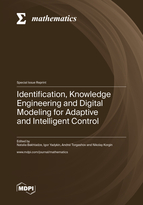Identification, Knowledge Engineering and Digital Modeling for Adaptive and Intelligent Control
A special issue of Mathematics (ISSN 2227-7390). This special issue belongs to the section "Dynamical Systems".
Deadline for manuscript submissions: closed (20 October 2022) | Viewed by 23681
Special Issue Editors
Interests: identification of control systems; estimation theory; adaptive control; model predictive control; data mining; wavelet analysis; control of technological processes in industry and energy; multi-agent systems
Special Issues, Collections and Topics in MDPI journals
Interests: power systems analysis; power systems simulation; adaptive and optimal control; mechanical engineering
Special Issues, Collections and Topics in MDPI journals
Interests: system identification; predictive modeling; advanced process control
Special Issues, Collections and Topics in MDPI journals
Interests: mechanism design; game theory; power systems analysis; mechanical engineering; identification problems
Special Issues, Collections and Topics in MDPI journals
Special Issue Information
Dear Colleagues,
The Special Issue aims to bring together scientists working in various branches of control theory to discuss manufacturing control problems, including: enterprise control and digital ecosystem creation, the development of identification theory and methodology, the related mathematical problems, parameter and nonparametric and structure identification and expert analysis, problems of selection and data analysis, control systems with identifier, modelling in intelligent systems, simulation procedures and software, digital identification, reinforcement learning, quantum modeling, intelligent model predictive control, predictive cognitive issues, problems of software quality for complex systems, and global network resources of support processes of modeling and control.
Prof. Dr. Natalia Bakhtadze
Prof. Dr. Igor Yadykin
Prof. Dr. Andrei Torgashov
Prof. Dr. Nikolay Korgin
Guest Editors
Manuscript Submission Information
Manuscripts should be submitted online at www.mdpi.com by registering and logging in to this website. Once you are registered, click here to go to the submission form. Manuscripts can be submitted until the deadline. All submissions that pass pre-check are peer-reviewed. Accepted papers will be published continuously in the journal (as soon as accepted) and will be listed together on the special issue website. Research articles, review articles as well as short communications are invited. For planned papers, a title and short abstract (about 100 words) can be sent to the Editorial Office for announcement on this website.
Submitted manuscripts should not have been published previously, nor be under consideration for publication elsewhere (except conference proceedings papers). All manuscripts are thoroughly refereed through a single-blind peer-review process. A guide for authors and other relevant information for submission of manuscripts is available on the Instructions for Authors page. Mathematics is an international peer-reviewed open access semimonthly journal published by MDPI.
Please visit the Instructions for Authors page before submitting a manuscript. The Article Processing Charge (APC) for publication in this open access journal is 2600 CHF (Swiss Francs). Submitted papers should be well formatted and use good English. Authors may use MDPI's English editing service prior to publication or during author revisions.
Keywords
- identification
- intelligent model predictive control
- enterprise control
- digital ecosystem creating
- reinforcement learning
- quantum modeling






